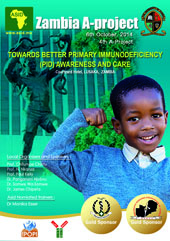Yousif Abdalla, Idriss Matoug, Hanan Alsalheen. Children's Hospital, Faculty of Medicine, Benghazi University, Benghazi, Libya.
Traduit par Dr L Jeddane, Maroc.
L’agammaglobulinémie est un deficit immunitaire primitive, où le patient présente un blocage de la maturation des lymphocytes B dans la moelle osseuse, aboutissant à des taux d’immunoglobulines sériques bas ou absents (1). On reconnait 3 types d’agammaglobulinémie : liée à X, précoce et tardive.
Nesrine Radwan, Pédiatre, Hôpital d’Enfants, Faculté de médicine, Université Ain Shams, le Caire, Egypte.
Traduction : Jeddane Leïla, Maroc
Le déficit en molécules d’adhésion leucocytaire (LAD) est un déficit immunitaire primitif rare de transmission autosomique récessive, dans lequel on observe un défaut d’agrégation des phagocytes au site de l'infection du fait de l'absence d'intégrines de surface. Elle est caractérisée par des infections récurrentes, des abcès sans pus, un défaut de cicatrisation et une hyperleucococytose. Le principal problème résulte d'une altération de l'émigration des leucocytes des vaisseaux sanguins vers les sites d’infection, ce qui nécessite l'adhésion des leucocytes à l'endothélium. A ce jour, trois types de LAD (I, II, et III) ont été identifiés. Le diagnostic repose sur l'analyse par cytométrie de flux des neutrophiles pour l'expression de CD11, CD18 et CD15s à la surface des leucocytes. Les options de traitement comprennent l’antibioprophylaxie etla greffe de moelle osseuse si un donneur compatible est disponible.
Fethi MELLOULI, National Center of Bone Marrow Transplantation, Tunis, Tunisia
Translation: Jeddane Leïla, Morocco
Ahmed is a 7 months-old boy from 1st-degree cousins of Tunisian origin. His medical history reveals earlier death of two brothers from severe infection. His illness began at the age of three months by recurrent broncho-pulmonary and digestive infections, extensive oral thrush resistant to local antifungal treatment and purulent otitis.
Nesrine Radwan, Lecturer of Pediatrics, Children’s Hospital, Faculty of Medicine, Ain Shams University, Cairo, Egypt.
Leukocyte adhesion defect (LAD) is a rare, autosomal recessive primary immunodeficiency, in which there is defective phagocyte aggregation at the site of infection due to the absence of surface integrins. It is characterized by recurrent infections, non purulent abscesses, defective wound healing and marked leukococytosis. The main problem results from an impaired step in the inflammatory process, namely, the emigration of leukocytes from the blood vessels to sites of infection, which requires adhesion of leukocytes to the endothelium. So far, three types of LAD I,II, and III have been identified. The diagnosis is based primarily on flow cytometric analysis of neutrophils for the surface expression of CD11, CD18 and CD15s on leucocytes. Treatment options include antibiotics and bone marrow transplantation if suitable donor is available.



























